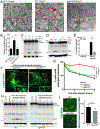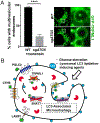Selective Lysosome Membrane Turnover Is Induced by Nutrient Starvation
- PMID: 32916093
- PMCID: PMC8337093
- DOI: 10.1016/j.devcel.2020.08.008
Selective Lysosome Membrane Turnover Is Induced by Nutrient Starvation
Abstract
Lysosome function is essential for cellular homeostasis, but quality-control mechanisms that maintain healthy lysosomes remain poorly characterized. Here, we developed a method to measure lysosome turnover and use this to identify a selective mechanism of membrane degradation that involves lipidation of the autophagy protein LC3 onto lysosomal membranes and the formation of intraluminal vesicles through microautophagy. This mechanism is induced in response to metabolic stress resulting from glucose starvation or by treatment with pharmacological agents that induce osmotic stress on lysosomes. Cells lacking ATG5, an essential component of the LC3 lipidation machinery, show reduced ability to regulate lysosome size and degradative capacity in response to activation of this mechanism. These findings identify a selective mechanism of lysosome membrane turnover that is induced by stress and uncover a function for LC3 lipidation in regulating lysosome size and activity through microautophagy.
Keywords: ATG5; LAP; LC3; ammonium; autophagy; glucose; glutamine; lysosome; metabolism; microautophagy.
Copyright © 2020 Elsevier Inc. All rights reserved.
Conflict of interest statement
Declaration of Interests The authors declare no competing interests.
Figures





Comment in
-
Getting picky with the lysosome membrane.Autophagy. 2021 Apr;17(4):1034-1036. doi: 10.1080/15548627.2021.1877935. Epub 2021 Jan 26. Autophagy. 2021. PMID: 33499722 Free PMC article.
Similar articles
-
Getting picky with the lysosome membrane.Autophagy. 2021 Apr;17(4):1034-1036. doi: 10.1080/15548627.2021.1877935. Epub 2021 Jan 26. Autophagy. 2021. PMID: 33499722 Free PMC article.
-
Stress-induced microautophagy is coordinated with lysosome biogenesis and regulated by PIKfyve.Mol Biol Cell. 2024 May 1;35(5):ar70. doi: 10.1091/mbc.E23-08-0332. Epub 2024 Mar 27. Mol Biol Cell. 2024. PMID: 38536415 Free PMC article.
-
V-ATPase and osmotic imbalances activate endolysosomal LC3 lipidation.Autophagy. 2015;11(1):88-99. doi: 10.4161/15548627.2014.984277. Autophagy. 2015. PMID: 25484071 Free PMC article.
-
The lysosome as an imperative regulator of autophagy and cell death.Cell Mol Life Sci. 2021 Dec;78(23):7435-7449. doi: 10.1007/s00018-021-03988-3. Epub 2021 Oct 30. Cell Mol Life Sci. 2021. PMID: 34716768 Free PMC article. Review.
-
Lysosomal microautophagy: an emerging dimension in mammalian autophagy.Trends Cell Biol. 2024 Jul;34(7):606-616. doi: 10.1016/j.tcb.2023.11.005. Epub 2023 Dec 15. Trends Cell Biol. 2024. PMID: 38104013 Review.
Cited by
-
Balancing lysosome abundance in health and disease.Nat Cell Biol. 2023 Sep;25(9):1254-1264. doi: 10.1038/s41556-023-01197-7. Epub 2023 Aug 14. Nat Cell Biol. 2023. PMID: 37580388 Review.
-
Glucose starvation causes ferroptosis-mediated lysosomal dysfunction.iScience. 2024 Apr 12;27(5):109735. doi: 10.1016/j.isci.2024.109735. eCollection 2024 May 17. iScience. 2024. PMID: 38706843 Free PMC article.
-
How does the neuronal proteostasis network react to cellular cues?Biochem Soc Trans. 2024 Apr 24;52(2):581-592. doi: 10.1042/BST20230316. Biochem Soc Trans. 2024. PMID: 38488108 Free PMC article. Review.
-
Lysosomal Repair in Health and Disease.J Cell Physiol. 2025 May;240(5):e70044. doi: 10.1002/jcp.70044. J Cell Physiol. 2025. PMID: 40349217 Free PMC article. Review.
-
The FMRFamide Neuropeptide FLP-20 Acts as a Systemic Signal for Starvation Responses in Caenorhabditis elegans.Mol Cells. 2021 Jul 31;44(7):529-537. doi: 10.14348/molcells.2021.0051. Mol Cells. 2021. PMID: 34140426 Free PMC article.
References
-
- Cai X, Xu Y, Cheung AK, Tomlinson RC, Alcazar-Roman A, Murphy L, Billich A, Zhang B, Feng Y, Klumpp M, et al. (2013). PIKfyve, a class III PI kinase, is the target of the small molecular IL-12/IL-23 inhibitor apilimod and a player in Toll-like receptor signaling. Chem Biol 20, 912–921. - PMC - PubMed
-
- Dikic I (2017). Proteasomal and Autophagic Degradation Systems. Annu Rev Biochem 86, 193–224. - PubMed
Publication types
MeSH terms
Substances
Grants and funding
LinkOut - more resources
Full Text Sources
Research Materials

